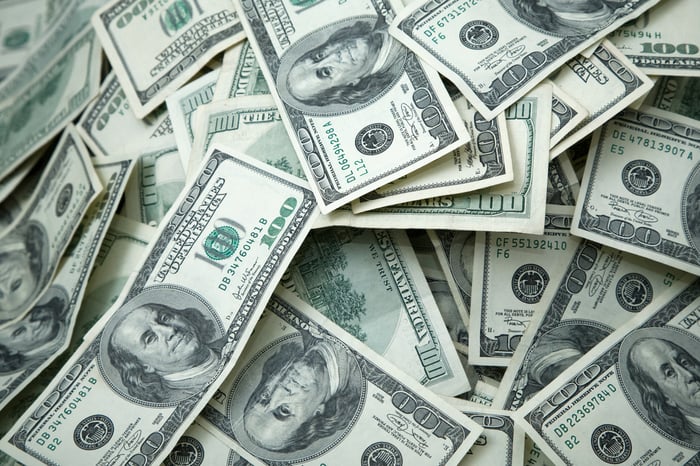Where Will XRP Be in 5 Years?

Key Points
Ripple, the company behind XRP, has applied for a national trust bank charter.
Approval could drive further investor enthusiasm and XRP's price higher in the near term.
Long term, however, it could actually drag XRP's price down.
XRP (CRYPTO: XRP) is having a monster year. The third-largest cryptocurrency is up more than 400% since September of last year. While much of this was driven by the resolution of the Securities and Exchange Commission's years-long lawsuit against Ripple, the company behind XRP, new catalysts are continuing to drive investor interest.
Where to invest $1,000 right now? Our analyst team just revealed what they believe are the 10 best stocks to buy right now. Learn More »
Now Ripple is applying for a U.S. national trust bank charter, further fueling bullish hopes for the token. So is now the time to buy in? Where might XRP be in five years?
A banking charter could accelerate Ripple's adoption
If approved by the Office of the Comptroller of the Currency -- the top banking regulator in the country -- Ripple's status as a national trust bank would allow it to officially custody assets and oversee client funds within traditional banking and financial management. This would help Ripple more seamlessly serve institutional clients and integrate its technology into legacy payment systems.
It's important to note, however, that a national trust bank is distinct from a retail or commercial bank -- it can't accept deposits or make loans. Still, this would undoubtedly help lend credibility to Ripple and accelerate the adoption of its tech. Great news for XRP's price, right?
Banks love Ripple's technology, not necessarily XRP
The basic investment thesis for XRP has always been that as banks adopt Ripple's technology, demand for XRP will rise and its price will follow. The more widespread the adoption, the higher XRP's value.

Image source: Getty Images.
It makes total sense on its face: As banks adopt Ripple's payment systems, they must purchase and hold XRP to transact with. That creates demand pressure and shrinks the supply of XRP on the open market, driving XRP's price higher.
Here's the thing: Banks can use Ripple's settlement systems with little or no exposure to XRP at all. That's exactly how the majority of banks go about using Ripple's tech. While transacting in XRP can give you the most bang for your buck in speed and cost savings, you introduce a substantial amount of risk to every transaction.
XRP is too volatile for most institutions
That's because XRP is a volatile asset. There are plenty of trading days when its value has dropped like a stone, losing double-digits. While it's not quite as volatile as it was in its early days, it is still exponentially more so than, say, U.S. dollars. Just this July, XRP fell more than 10% in a single day. Banks do not make a habit of holding -- even temporarily -- highly volatile assets if they can avoid it.
Ripple knows this, and it's why RippleNet, its most widely used product, doesn't require banks to touch XRP, but still provides much of the cost and time savings. While Ripple's On-Demand Liquidity (ODL) often involves XRP as a "bridge," institutions don't hold it for long. They quickly convert in and out of it, exchanging XRP for different currencies -- hence the title of bridge.
And critically, ODL remains a niche product compared to RippleNet, used by smaller institutions that have liquidity issues. It's unlikely to ever see nearly as much volume as RippleNet. Widespread adoption of Ripple's payment systems is not going to have the effect on XRP that many investors believe.
The five-year reality check
While I think increased regulatory approval could send XRP higher in the short term, come the five-year mark, investors will have seen that increased adoption is not driving the price as they thought, and the hype will fade.
In fact, Ripple's approval as a national trust bank seems to me to be tied to its push into stablecoins -- a move that could actually hinder XRP appreciation. Ripple's RLUSD could replace XRP as the preferred bridge asset in ODL transactions, eliminating the need for even smaller institutions to, however briefly, hold XRP.
While I'm not going to predict a specific price, I think it has a good chance of trading lower in 2030 than it does today. There are better options in the crypto market.
Should you invest $1,000 in XRP right now?
Before you buy stock in XRP, consider this:
The Motley Fool Stock Advisor analyst team just identified what they believe are the 10 best stocks for investors to buy now… and XRP wasn’t one of them. The 10 stocks that made the cut could produce monster returns in the coming years.
Consider when Netflix made this list on December 17, 2004... if you invested $1,000 at the time of our recommendation, you’d have $651,345!* Or when Nvidia made this list on April 15, 2005... if you invested $1,000 at the time of our recommendation, you’d have $1,080,327!*
Now, it’s worth noting Stock Advisor’s total average return is 1,058% — a market-crushing outperformance compared to 189% for the S&P 500. Don’t miss out on the latest top 10 list, available when you join Stock Advisor.
*Stock Advisor returns as of September 15, 2025
Johnny Rice has no position in any of the stocks mentioned. The Motley Fool has positions in and recommends XRP. The Motley Fool has a disclosure policy.







